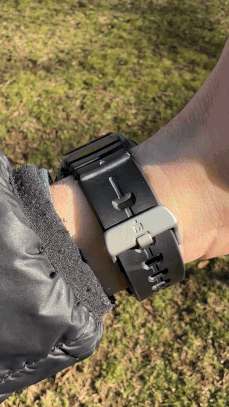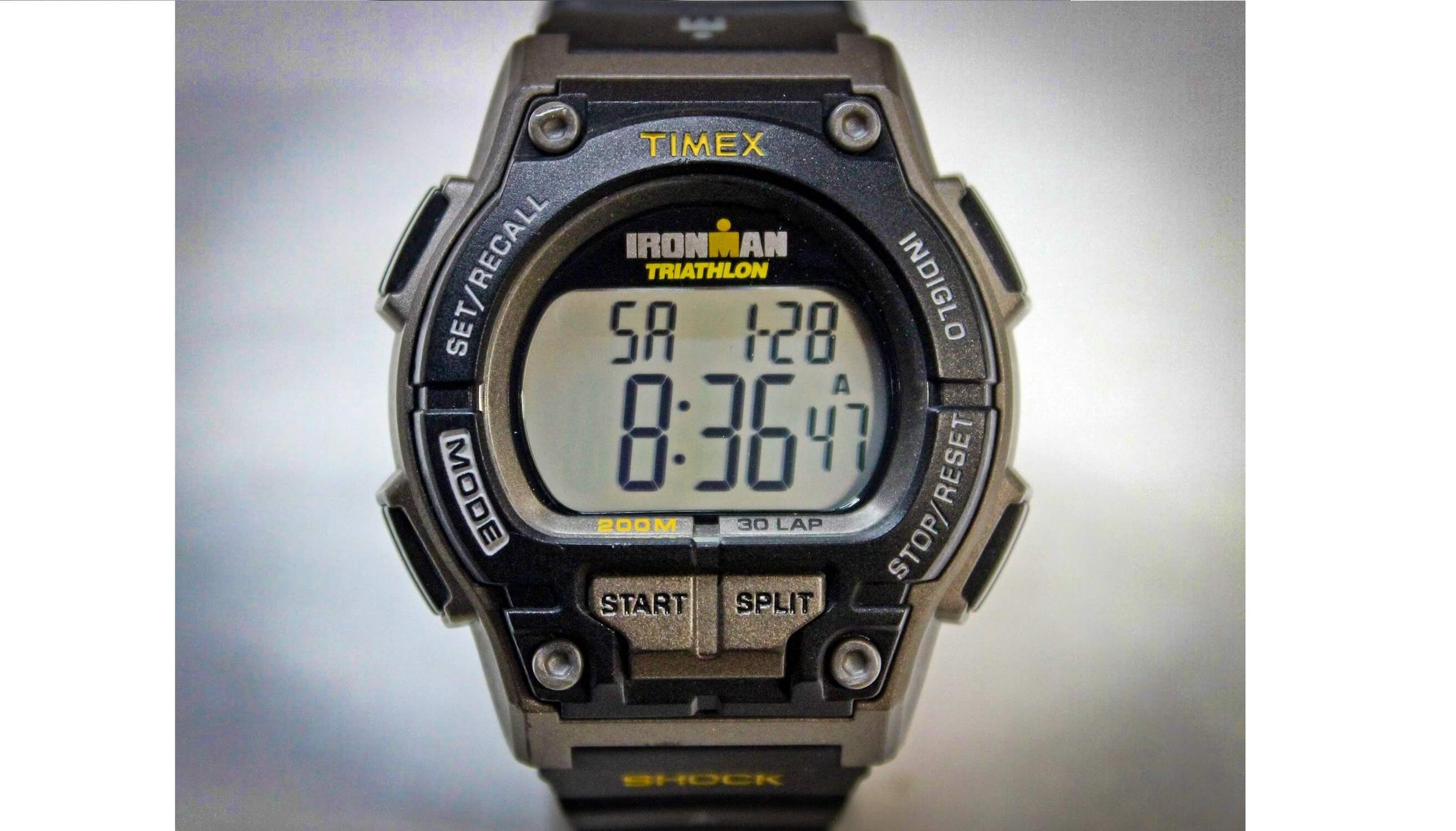Timex Ironman Triathlon Review | The Most Mileage For Your Money
(This page features affiliate links, for more information, click here.)
If there was a watch that identifies with 20th century digital design, the Timex Ironman would probably be at or near the top of the list. In a brilliant 1984 marketing concept, Timex sought to develop a timepiece that identified with the needs of and input from the very popular Ironman Triathlon event. By 1986 they’d succeeded in releasing an affordable, tough and easy-to-use design that would thus be worn not just by athletes of all sorts, but millions of people around the world.
Due to Timex experiencing less than ideal sales up to that point, the Ironman line was the grand slam that they needed, especially since they needed to compete with the release and success of the early Casio G-Shock releases of 1983 and onward.
Personally, I am very thankful to Timex, since I’ve owned at least one Ironman for the past 30 years. Having been a runner through the 1990’s I can say on good authority that the Ironman line always delivers on its promise to be accurate, tough, legible, and easy to wear. Even though I’m no longer a runner, the Ironman still delivers every day.
Timex vs Casio
For any niche product, it’s not always about “who made it first”, but who makes it better. So, my apologies go out in advance to the Casio G-Shock 5600 cultists, but the Ironman serves and contains the same overall functions, is just as tough for active day-to-day abuse, and takes up less real estate on your wrist. It also has a better weight distribution, so it feels much lighter, and it doesn’t tend to jiggle or bang around on your wrist when working out or running.
Indiglo aside, day-time legibility for the Ironman is also miles ahead of G-Shock, which is a major sticking point with athletes who often only wish to glance at the chrono function while keeping their pace and form intact. It's also worth mentioning that this particular upper-trim Ironman, with the 200m water resistance (WR) and built in Anti-Shock components, is usually $10 cheaper than the base G-Shock 5600.
Additionally, base model Ironman watches, which aren’t covered in this article, can be obtained all day, every day from all the major online retailers for around $25, which lends even further to the Ironman’s affordability and accessibility to all.
CONSTRUCTION
This isn’t to say I didn’t give G-Shock it’s fair chance. I’ve owned several over the years. Aside from running, I’ve conducted research scuba diving, worked as a deckhand on commercial fishing vessels and still regularly go surfcasting for striped bass throughout the New England shoreline every chance I get. I also try to swim for exercise 4-5 times per week.
Sadly, on several occasions over the years the G-Shock didn’t withstand the ocean-borne activities. The sea would always find its way into the case somehow. Often the module would continue to function, but the salt-laden moisture would kill the electronics eventually. This Timex Ironman T5K195 has been battered by the salty waves and the chlorine more times than I can remember over the past 5-6 years, and it hasn’t had any issues whatsoever. Perhaps G-Shock is better suited to “shocking” environments, but from my experience, I’m sure Timex will be happy to know that this piece has certainly “taken the licking” I’ve given it.
Granted, it’s not the best watch to pair with your wedding tuxedo, but it will definitely serve and obey you for better or worse all the days of its life. This model was purchased directly from Amazon for $43 USD. Not a bad price for a tough watch with 200m WR that will likely last you at least 15 years of daily use. Even though this watch comes with a standard manufacturer’s warranty of 1 year from the date of purchase, Timex gives you the option to purchase an additional 4 years for $5. A bit of a strange move by Timex, but an option for the buyer, nonetheless.
Since I’m used to reviewing dive watches that are made of metals, I had to do some homework with this Ironman. As far as materials go, you’ll find a very tough resin case with integrated pushers, two on each side with another at the bottom-center. The button sizing is just right and the action is immediate with just the right amount of pressure.
Dimensions & Dial
Starting with sizing, my digital calipers show a case size of exactly 42mm in width, a lug-to-lug of 49mm, and a case thickness of 15mm. The beefy case construction allows the mineral crystal width of 29mm with a more than legible display set deep underneath.
Beneath said crystal are two spacer rings, indicating “200 WR, 30 LAP” and “Ironman Triathlon” respectively. The top, bezel portion of the case is a matte black with clearly labeled button functions indicated in grey and stamped into the surface, not merely painted-on. The lower “case” portion of the case is a matte grey. All the finishing is plain flat surfacing, with no brushing or texture.
I was happy to learn this watch has an ISO rating for the anti-shock features. All the case elements are tightly constructed and fit into one another well; no strange or distracting gaps or dead spots that you might find on other plastic watches. Also, with no shiny or painted surfaces, you won’t need to look at ugly wear-through case material after a few years.
Features
The strap lug width is only 18mm but being an Ironman, the bracelet top corners are fitted to the case shape, measuring at 23mm and tapering down to 20mm toward the buckle. More on this strap later. Out of the box, this Ironman is almost a featherweight at 55 grams, so as with many fitness watches you won’t experience any top heaviness since the fitment on most wrists is as comfortable as can be.
The caseback is a 4-screw down style in stainless steel. With a slight bubble to raise the printed specs, it remains flat against the wrist. Upon it you will find the following etched info: Stainless Steel Caseback, 200 Meters Water Resistant, TIMEX Ironman Triathlon SHOCK, www.timex.com, T5K195, Battery CR 2016.
I find the inclusion of the battery type a welcome sight since it allows you to know and buy/order the proper battery instead of opening the caseback to find out. CR 2106 batteries are very easy to change, and they typically only cost $2-3 apiece, so this watch is more than affordable in the maintenance department as well. Even a mechanical novice would be able to change the battery with a single eye-glass screwdriver.
MODULE & FUNCTIONS
The actual display is crisp, with a good dark contrast on the numerals and no clutter. Being function-rich, it certainly offers the wearer all the uses of any other digital watch at most price points. No, smart watches don’t count.
At the default time keeping setting, the module will display the day and date along the top, with the time displayed underneath but in taller numerals. As said before, the time can be read at a glance. Far quicker than an analogue watch. The module allows selection of either a 12 or 24-hour time display as well as 2 time zones. So not only is it suitable for athletes but for travelers as well. Not an analogue GMT, but you do get that functionality should you need it. 99 lap split timing and 30 lap memory also certainly allows you to keep track of not only your own progress on the track or in the pool, but an entire team!
You also get a very capable 100-hour chronograph, I assume because of the limits of the numerals that can be displayed by the module. But it’s interesting to see Timex utilize as much time as they can squeeze out of this function. Though off-hand I can’t think of anything that needs to be timed precisely for more than 24 hours except perhaps a donated organ that is being transported to a very appreciative recipient. Now that I think of it, I wouldn’t be surprised if many doctors around the world wear an Ironman. I do know Dr. Anthony Fauci has worn one for years. If there was ever a person in recent memory to whom time has literally meant lives, it’s him.
If the chronograph function wasn’t capable enough, you also get a 24-hour capacity countdown timer as well, mated to an audible alarm. Another “maximum utilization” by Timex. Speaking of the alarm, you can also program the alarm for daily, weekday and/or weekend frequency. The alarm is clear, but not too loud, shrill or cheap sounding.
Indiglo
Yes, we all know that Indiglo is the king of lume, at least for digital watches, but this Ironman has another trick up its sleeve. The Indglo function gives the appearance of a “negative display” when activated, but a traditional look of dark numerals when not. When I thought the magic that is Timex Indiglo had been perfected years ago, this piece further turns things around to demonstrate how Timex is still willing to innovate. When you hit the Indiglo button, the numerals are lit blue-green against a dark background and not vice versa which has been the traditional Indiglo way. I can say I’m a fan. The numerals are so much easier to read in the dark in my opinion.
Furthermore, the wearer can select “night-mode”, which activates the Indiglo function when any button is pushed and not just the dedicated button. When toggled, the night-mode stays on for 8 hours, then turns itself off. Even the placement of the Indiglo button is perfect, right at the 2 o’clock position where it belongs. Overall, this display, the module, and the functions built within give you everything you could need and nothing you don’t. No room for improvement. It’s perfect.
BRACELET
The supplied bracelet, even though it looks underwhelming is still miles ahead of many other rubber straps we’ve come to know from all the big watch makers. It is curved to avoid damage if dropped “bottom-down”, much like G-Shock, and the rubber is slightly more supple and comes with a user-friendly strap keeper. The keeper grabs and sits itself between two raised notches that are molded onto the strap. One only needs to give the keeper a squeeze on the sides to release the end of the strap. It is a little stubborn at first, but breaks-in in no time.
The inner surfacing is also adept at allowing water to escape, much like an all-season tire tread. This pattern also allows adequate breathability as well. The metal blast-finished buckle also has a thick gauge and matches the finish of the case. Any other finish on the buckle would have looked awkward and out of place.
PACKAGING & WARRANTY
The packaging you’ll get with this piece is the standard “throw away” fare for a $45 Timex. Thin cardboard box with a plastic display stand, standard digital Timex instructions and tags. Were you expecting anything else? As you should have gathered by now, this watch is foremost about function and performing in the field, and least about the presentation via redundant packaging. If you’re looking for a Swiss-grade watch box, you’re missing the point of this piece. It’s designed to walk the walk.
The Good
Year after year of reliable use.
Legibility leaves nothing to be desired.
Ignorable weight, with perfect balance and feel.
Under $50!
Possible opinion-based drawbacks
Digital may not be your thing. But a perfect spare to throw into a drawer or suitcase.
The Marginal
Limited strap options with the integrated 18mm lug openings.













